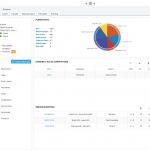
How analytics has changed football scouting
Sabermetrics, what made football an exact science
January 22nd, 2019
Many times during the football market windows we think that the transfers are a sort of raffle for the clubs, functional to a game module or necessary to cover sudden injuries. It is not considered that clubs aren't guided by instinct or emotional transport towards players, but rather on statistical parameters, real mathematical science that analyzes football in its numbers, leaving out the single case in favor of an average caught on numerous case studies. This science is called sabermetric, born in baseball and defined in David Grabiner's manifesto as "the search for objective knowledge". The American model has been adopted for years also in football, to build teams, victories and built the foundations for projects that help small teams to bridge the objective economic gap.

This scientific approach to sport born in baseball and archived celebrity thank to the film Moneyball (2011), in which Brad Pitt plays Billy Beane, who first brought Oakland Athletics to the playoffs with a team built entirely on data, and then the Boston Red Sox at the triumph in the World Series after 86 years. The analysis in baseball is much clearer because the sporting gestures have a more limited time duration, but it is important in being able to understand how an isolated play can influence a 162-long league if considered as a habit o technical characteristic of the single player, not to be modified but to be exploited as a cog in a coordinated system.
Actually, in the world of football using the stats allows middle-range teams to operate in an intelligent way, buying players with the right criteria and thus reducing the economic gap with the big ones. Sometimes picking in the lower series, a "risk" that the top clubs can hardly afford to take. Taking as an example the last Premier League seasons, two excellent examples of this increasingly tested system are James Pickford and Lewis Cook, bought respectively by Everton and Bournemouth with well-chosen operations, quickly became ideal purchases. Among clubs that work in this direction there is also Burnley, the small English club that has used statistics in a good way to improve its squad, aiming only to the objective adaptability to the game system and to the opponents of the league, not bothering to negligible details such as age. An example in this sense is the signing of James Tarkowski, bought from the Championship and initially considered unsuitable for the Premier League defensive level but instead perfect, according to stats, for the compact attitude of the defense of Sean Dyche team. Now he is one of the best centre-backs in the league and has also reached the National team. The same can be said about Ranieri's Leicester and weighted signings like those of Kante, Mahrez and Ndidi, assessed on the effectiveness of their game in the field. Relying on the data is a courageous strategy, because it accepts short-term failure, aiming for a more long-lasting success and solidity, which is why it was easier to do for teams that did not have the obligation to win in the immediate. Spending a little using statistics is proving more effective than investing heavily in scouts.
The approach is now used by major European clubs, which may have larger facilities and Scout network. In Italy, it all started in 2004, when Genoa, coached by Serse Cosmi understood the potential of the project of Wyscout, a data analysis company based in Chiavari and still, together with Opta and Instat, at the base of the biggest clubs world projects.
Except for advertising, the purely technical concept that drives acquiring campaigns is the functionality. One of the examples is when Deco join Barcelona in 2004, acquired for his ability to retrieve the balls, and "rejected" by Wenger, looking for a player who covered more field during the game. The choice fell on Olympique Marseille midfielder Mathieu Flamini, who had an average of 14 kilometers run. Also in 2004, Bolton invested in Gary Speed, 35 years old but with a physical condition, according to data, higher than Frank Lampard and Steven Gerrard, much younger than Speed.
This is why scouts have increasingly based his analysis on tools, in the case of football:
- recovered balls and lost balls
- km routes and number of sprints
- fouls did and committed
- successful cross
- contrasts won and lost
- wrong cross
- yellow and red cards
- the effectiveness of the shot
- decisive assists
- decisive goals.
The sabermetric is, therefore, a well-established approach to sport, which excludes the occasional event in favor of an average of cases, with the aim of a search for objectivity in evaluation, which excludes feelings in market choices. The algorithm does not look of the passion or history of the players but gives us the clearest image of the potential of a team. Tifo Football has explained the progress of analytics in Premier League with an interestig illustrated video.

















